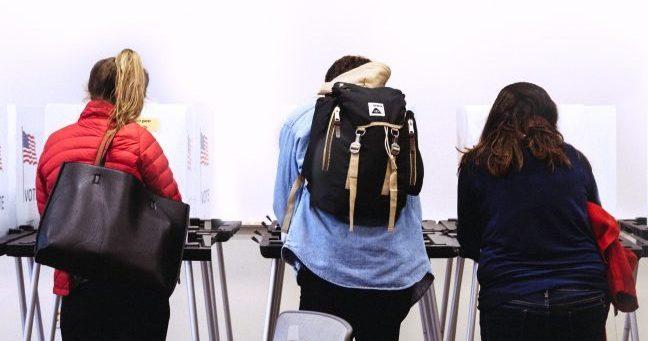In light of the University of Wisconsin’s decision to join in the Big Ten Voting Challenge, UW experts and student leaders discussed reasons for chronically low voter turnout in the United States when compared to other advanced democracies, particularly among young voters.
On Sept. 18, UW Chancellor Becky Blank announced her decision to join several other Big Ten universities in the Big Ten Voting Challenge, which aims to increase civic participation among student populations.
UW looks to encourage civic duty through Big Ten voting challenge
When compared to other democracies, UW Journalism and Mass Communications assistant professor Michael Wagner said the U.S. has a considerably smaller average voter turnout.
In the U.S., roughly 60 percent of its eligible population voted in the general election in 2016, according to the nonpartisan election database FairVote.
Data from FairVote also revealed that U.S. midterm elections have consistently seen an average voter turnout of roughly 40 percent since 1974, a number which is 20 percent less than turnout in the 2016 presidential election.
“Voter participation in the U.S. is lower than a lot of other advanced democracies, most notably Australia,” Wagner said. “A lot of other advanced industrial democracies in Western Europe have more impressive voter turnout than the United States does.”
In data from a Pew Research Center report this year, several countries were identified with voter turnout above or close to 80 percent, even reaching 87 percent in Belgium, where voter turnout is highest. After Belgium, these countries include Sweden, South Korea, Denmark and Australia.
Wagner said these voter participation disparities have a variety of explanations, ranging from compulsory voting in some countries to easier voter registration in others.
In the United States, Wagner said differences in the number of laws related to voter registration and the strictness by which states enforce these laws can account for low voter participation numbers. These laws can also explain variations in voter turnout between the different states.
Wisconsin voter turnout, as reported by FairVote, has been consistently higher than the national average. The state has ranked in the top five among the 50 states since the 2012 elections, ranking second in the nation in 2012 and 2014 and fifth in 2016.
Despite Wisconsin’s high national rank, the state sees a consistent voter turnout in the range of only 60 to 70 percent in presidential elections. In the 2014 midterm elections, when the state’s voter turnout ranked second in the nation, FairVote reported that only 56 percent of eligible Wisconsinites voted.
“In Wisconsin, you can register on the day of the election, but in other states, you can’t,” Wagner said. “Surprise, surprise, Wisconsin has higher voter turnout than other states.”
Campus leaders advocate for out-of-state student voting rights
An aspect of voting in the United States which the Big Ten Voting Challenge hopes to address specifically is youth turnout, which is considerably lower than other age demographics.
According to information from the Center for Information and Research on Civic Learning and Engagement, roughly 50 percent of 18 through 29-year-olds voted in 2016, which is ten percent less than the aggregate 2016 percentage.
An explanation for low turnout among young voters, Wagner said, is the decision by electoral candidates and campaigns to not target younger voters.
“Most of it is a targeting issue,” Wagner said. “Most campaigns don’t waste resources on trying to encourage younger voters to participate.”
Laurel Noack, the Vote Everywhere Ambassador at the Morgridge Public Service Center, said young Americans feel disappointed by a government which doesn’t reflect them or offer them “a seat at the table,” which can explain why young voters participate at such low levels.
Getting more millennials to run for office, Noack said, is a good way to excite young voters and increase participation in that age demographic.
“When you don’t see yourself being reflected in politics — when you don’t see young people out there getting elected — it’s definitely not encouraging,” Noack said. “Maybe with more millennials running for office, we’ll have more millennials voting.”
Big Ten Voting Challenge aims to increase voting participation among students
On campus, Noack said it is her goal to make the Big Ten Voting Challenge worthwhile.
Noack said this will include working with student demographics with particularly low voter participation rates, which she said includes students in STEM majors.
“I know it’s called a challenge for a reason,” Noack said. “We’ve seen significant drops in several different types of students studying other majors than the social sciences, and we’re really trying to reach out to STEM majors this coming semester.”
With the 2018 midterm elections roughly a year away, the efficacy of efforts like the Big Ten Voting Challenge and the Vote Everywhere campaign has yet to be seen.














